Best smart lighting 2020 – top smart light bulbs and light switches
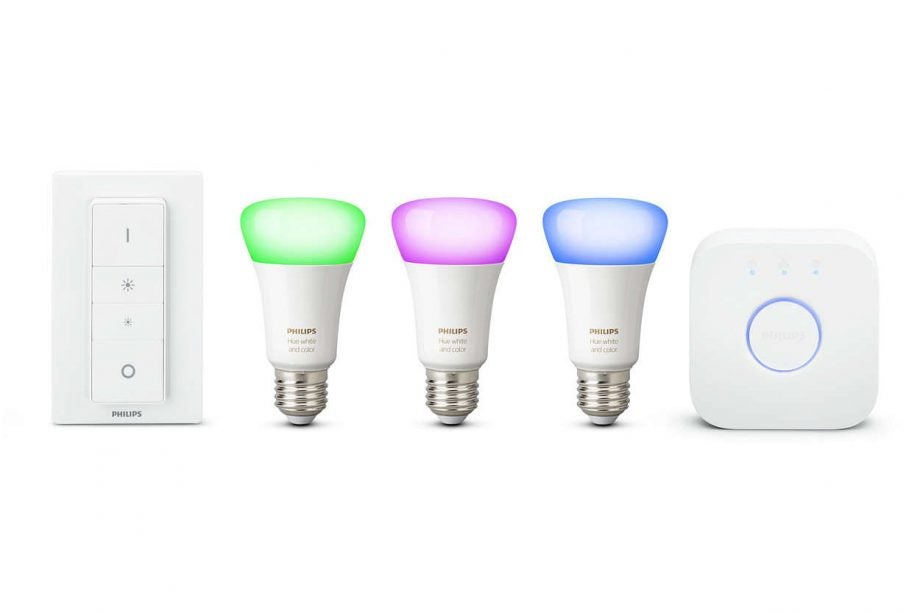
Smart lighting can be quite incredible, transforming the way that you use light in your home. From improving convenience and boosting security to the option of bathing your home in light, there are a lot of things to think about when choosing the best smart lighting system. We’re here to help.
We’ve reviewed all the major lighting systems and options, but out of everything two systems stand out. Philips Hue is by far the best overall system with the widest choice of products and controls. If you just want to make your existing bulbs smart with attractive dimmers, then the Lightwave Generation 2 system is the best option.
How we choose the best smart lighting
There are two types of smart lighting: smart bulbs and smart switches. Smart bulbs plug into your existing light fittings and come in three different types: dimming, temperature-changing and colour-changing.
Smart light switches replace your existing switches with ones that you can remote control. As they work with your existing bulbs, you can only dim your lights, but you can’t change colour or temperature.
For smart bulbs, we look at the range of options. Having a wider choice of bulb fittings is essential so that it’s easier to upgrade your existing bulbs. Ease of installation is very important, as smart bulbs have to be linked up to your home network to enable remote control.
Next, we look at the app and how intuitive it is to use. We test a wide range of features, from simply turning lights on or off to setting scenes. We look to see how quickly bulbs respond to commands.
Next, we look at the alternative control options, as it can be useful to have dedicated wireless switches or buttons, so you can use your smart bulbs in the same way as older ‘dumb’ lighting.
We look at the quality of the light produced and how bright the bulbs are. For colour or temperature-changing bulbs we look at the range of options available and the quality of the light.
For smart light switches, we wire each model into a few different light fittings to test compatibility with several normal bulbs. In the UK, most smart switches are dimmers, as there’s typically no neutral cable; to keep power flowing for smart control, smart switches don’t turn off, but merely dim bulbs to the point where there’s no light coming from them. That’s the theory, so testing with multiple bulb types lets us test that: typically, smart switches can struggle with some LED GU10 bulbs, either leaving them on permanently or causing them to flicker.
Again, app control is tested to see how quickly switches respond to commands. Plus we test advanced features, such as scheduling lights.
For both types of smart lighting, we test voice control options, testing (where possible) with Amazon Alexa, Google Assistant and Apple Siri. Where available, we test integrations with other smart home systems, including IFTTT, Samsung SmartThings and Apple HomeKit.
[videoai keywords=”” iab_category=””]
1. Philips Hue
The most versatile system with plenty of manual controls.
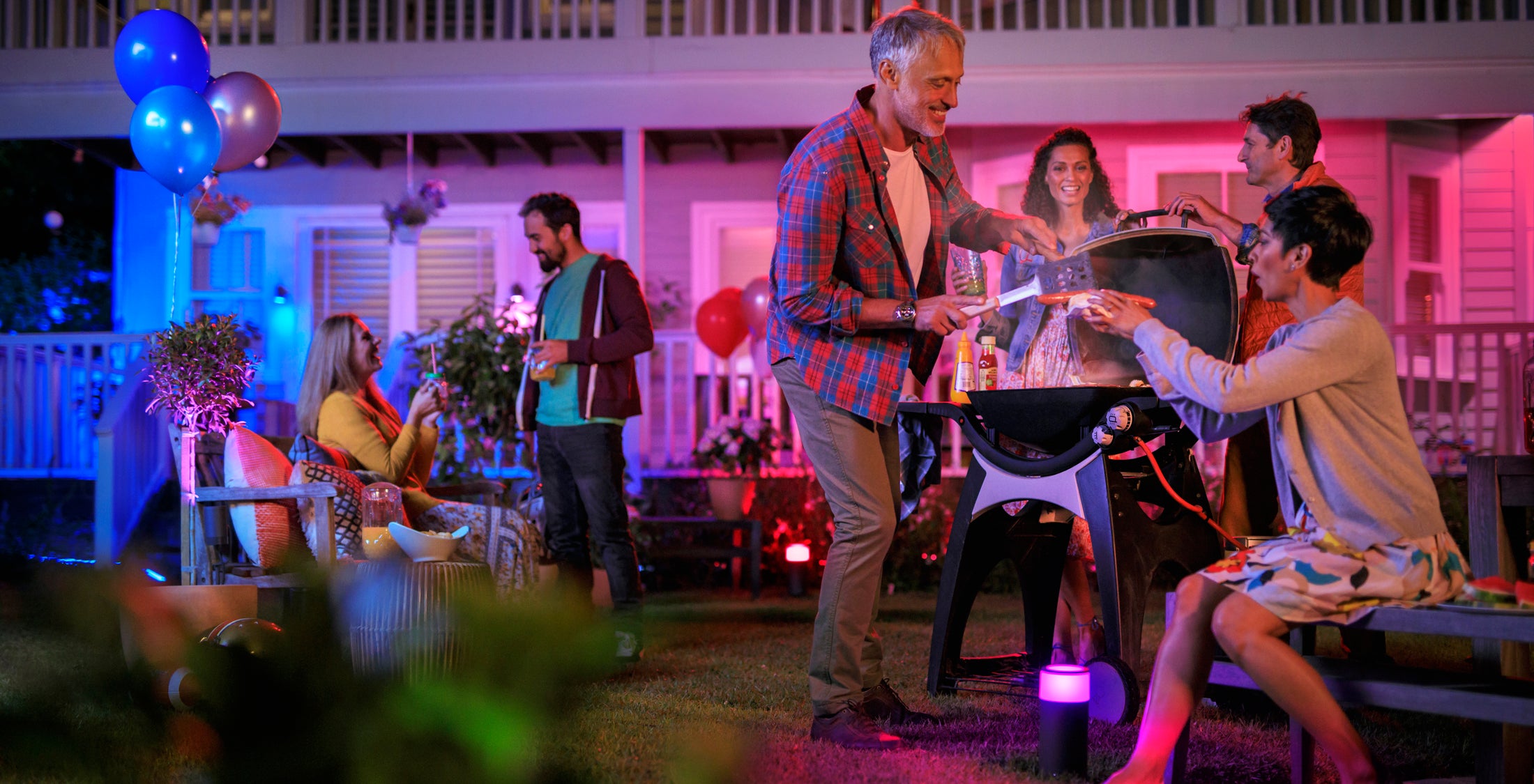
Pros:
- High-quality white, temperature-changing and colour lightbulbs
- An outstanding ecosystem of apps
- Large range of add-on lights
- IFTTT recipe support
Cons:
- Plastic remote controls
- Can’t save colours or temperatures easily
Philips Hue is the best-known smart lighting system, and it’s also the best. The smart bulbs come in a huge range of fittings, including B22, E14, E27 and GU10, plus there are plug-in options with LED strips, lamps and even dedicated outdoor lights.
Related: Which Philips Hue bulbs should I buy?
Within those choices, you can choose from standard warm-white dimming, temperature-changing and colour-changing bulbs. All bulbs are of the highest quality, easily replacing your existing bulbs and providing more than enough illumination.
Opt for the temperature or colour-changing bulbs and your lighting becomes more arty, letting you change the mood and feel of the room you install them in. If you’re looking for a wow factor for a room, then Hue is the system to go for.
Hue uses the Zigbee smart home wireless protocol, which means you need the Hue Bridge hub to be connected to your home network. Using Zigbee has advantages, the main one being that there are loads of control options, including a wireless dimmer switch, motion sensor and even a battery-free kinetic switch that is powered by the force of clicking buttons.
With Apple Siri, Amazon Alexa and Google Assistant support, Philips Hue is supported by all the major voice assistants. Thanks to Hue’s popularity, it’s also the system that’s best supported by third-party services, too. For example, Works With Nest support can turn your Hue bulbs red when a Nest Protect detects smoke. In short, for the widest choice from bulbs to controls, Hue is the system to buy.
2. Lightwave Generation 2
A clever way to make your existing dumb bulbs smarter
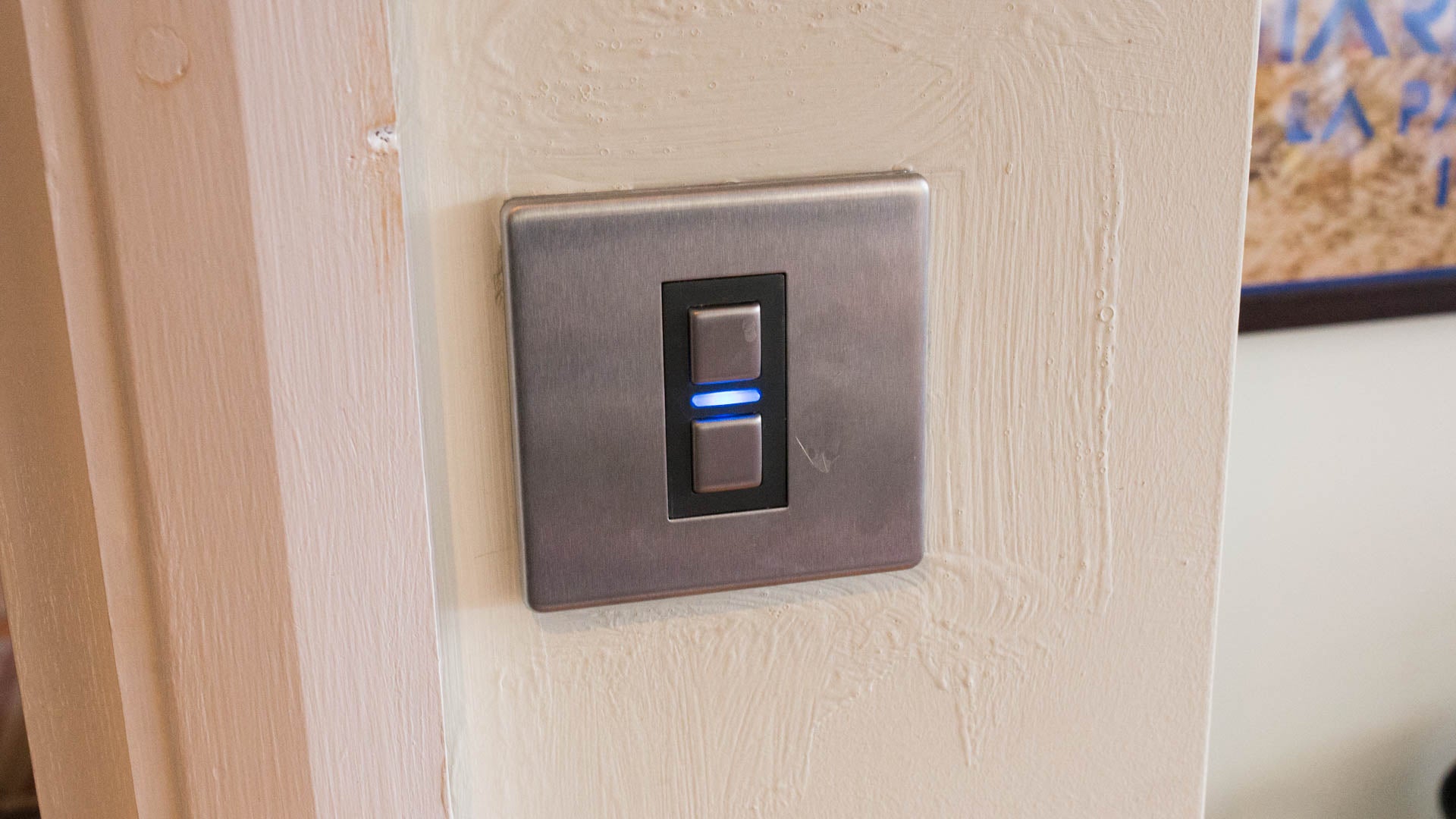
Pros:
- Quality dedicated switches
- Devices have two-way communication
- Works with existing bulbs and lamps
Cons:
- Fewer control options than the original system
- No colour-changing options
The downside of smart lightbulbs is that many don’t have physical switches as an option and, for those that do, they can look a bit cheap. Lightwave’s answer is high-end smart switches that look fantastic and can be used like ‘normal’ ones, with the added benefit of smart control.
With Lightwave Generation 2 products and the new hub, Lightwave has improved compatibility with LED bulbs. GU10 compatibility can still be a bit hit-and-miss, but buy branded dimmable bulbs, such as from Philips, and you shouldn’t have problems.
From the switches, you can turn lights on or off, or hold the up or down buttons to brighten or dim your lights respectively. App control lets you do the same thing, locally or remotely. And you can schedule your lights to come on or off automatically, either to provide a night light or for that added bit of security.
Google Assistant, Amazon Alexa and Apple Siri support are great to see, but Lightwave doesn’t have the same level of third-party support as some other bulbs; there’s no Works with Nest support, for example.
If you’re not worried about colour-changing bulbs and want a classy-looking system that gives you physical, as well as smart control, Lightwave Generation 2 is the product for you. And the system can be expanded, with smart power sockets, too.
3. LIFX
A powerful system of connect bulbs that uses Wi-Fi
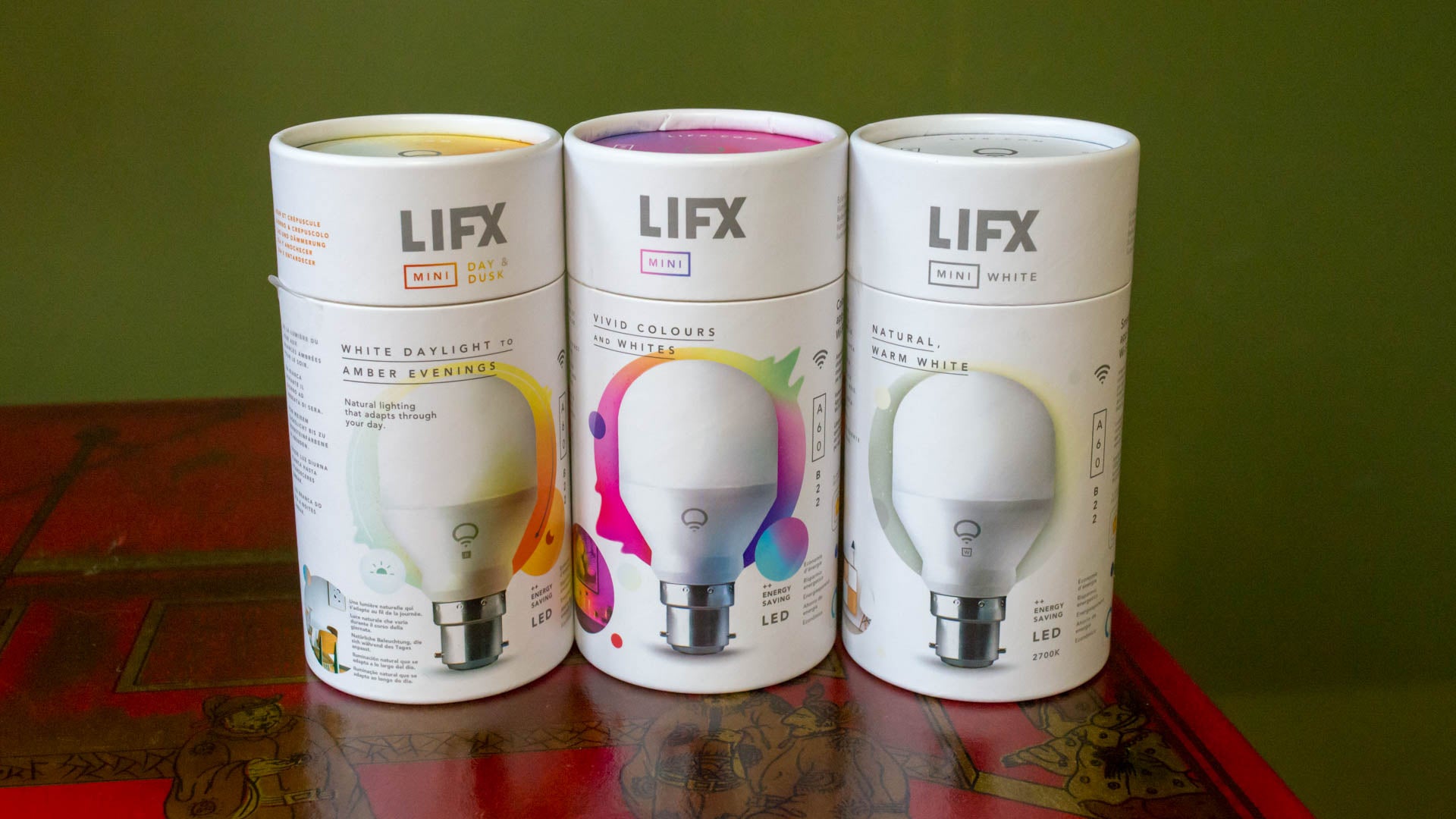
Pros:
- High-quality white, temperature-changing and colour lightbulbs
- Powerful app control
- Support for every voice assistant
Cons:
- Fiddly to set up
- Apple Home didn’t control temperatures properly
LIFX bulbs are some of the best out there, particularly with the LIFX Mini bulbs. Mini bulbs are available in E27 and B22 fittings, but there are GU10 and LED strips options, too. You can get dimmable, temperature-changing and colour-changing options. For the latter two, the LIFX Mini bulbs have greater range than their Hue equivalents.
LIFX Mini use Wi-Fi to connect to your home network. This means that you don’t need yet another smart home hub, but the downside is that you need strong Wi-Fi and metal lampshades can impede performance. Also, installation is a little more long-winded than with Hue.
A second issue is that you can’t have Wi-Fi remote controls, as batteries wouldn’t last long enough for them to be useful. However, LIFX bulbs are controllable with third-party smart buttons including the Flic Hub and Logitech Pop.
What makes LIFX particularly good is the brilliant app. As well as being able to set scenes and control brightness and colour, the app also has plenty of dynamic modes. From gently shifting colours to scenes that let your phone’s microphone change colour in time to the beat of music, LIFX is great fun to use.
Third-party support is up there with Philips Hue, with practically every system supporting the bulbs including Works with Nest. Voice assistant support is up there, too, with Amazon Alexa, Google Home and Apple Siri support. However, for the latter, each bulb has to be manually added into Apple HomeKit; with Hue, you only need add the bridge and then all lights are found straight away.
4. Nanoleaf Canvas
Create a wall of arty, interactive ligts with this system
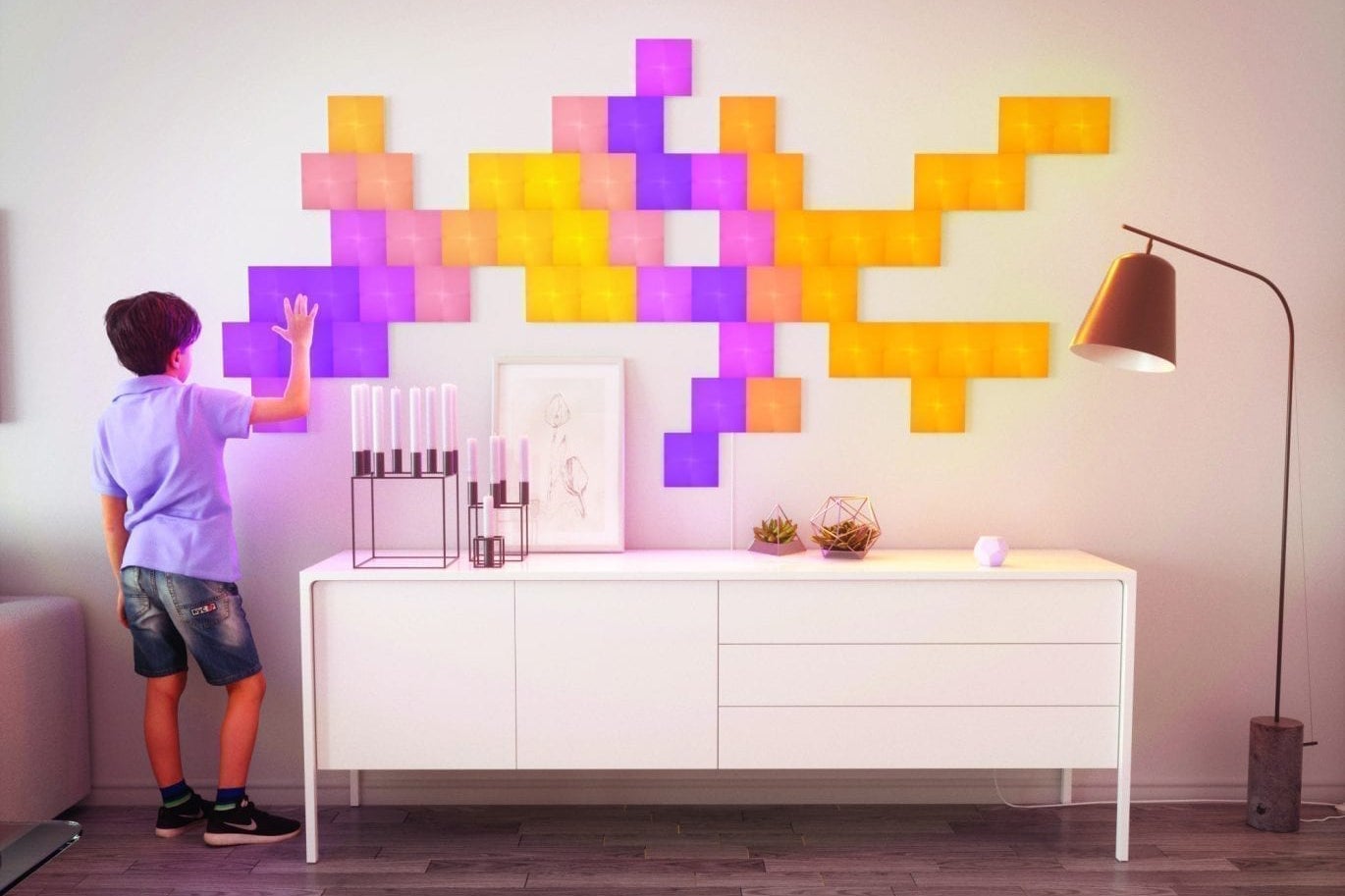
Pros:
- Lots of configuration options
- Dynamically changes colour to music
- Excellent colour range
- Interactive display
Cons:
- Fiddly app
- A little tricky to physically set up
If you want something a little more artistic and fun, the Nanoleaf Canvas is for you. These smart squares of LED lights bolt together and stick to your walls, letting you create a fun light installation. At its most basic, the Nanoleaf Canvas lets you set the basic colours of the squares. To take it a bit further, you can switch to use motion lights, with the Canvas cycling through different colours. Turn on the Rhythm feature and the lights will even change in time with your music.
These are the first touch-sensitive lights that we’ve tested. Gestures let you set what happens when you move your hand up, down, left or right across the lights, including changing the scene or adjusting the brightness. Fancy something a bit different, then there are interactive games, too, such as whack-a-mole.
The app’s a little fiddly to configure, but the overall fun and quality of the lights make up for this. You get nine panels in the box, but you can add later if you want to expand your coverage.
5. LIFX Beam
Add interactive strip lights to your home.

Pros:
- Engaging and fun lighting
- Excellent app control
- Easy to configure
Cons:
- Relatively expensive
- Limited layout options
Sitting slightly separately from the main LIFX system, the LIFX Beam is a brilliant, fun product. You take the light strips and then connect them together to create something that’s more like an art installation, adding interest and complementing your existing lights.
Beam connects to your home network via Wi-Fi and is controlled via the excellent app. You can set different parts of the system different colours, painting with light, although dynamic lighting, such as colours chasing each other through the strips, adds a lot of fun. You can also use the app to get the Beam to change colour in time to any music you’re playing.
As with the main LIFX system, Beam’s support is excellent, with most third-party systems, including Works with Nest, supporting it. Amazon Alexa, Apple Siri and Google Assistant support are also available. There are no LIFX wireless switches, but Flic Hub and Logitech Pop support give you third-party control options.
6. Nanoleaf Light Panels Aurora Rhythm
Clever light panels that let you build interesting shapes that attach to your walls.
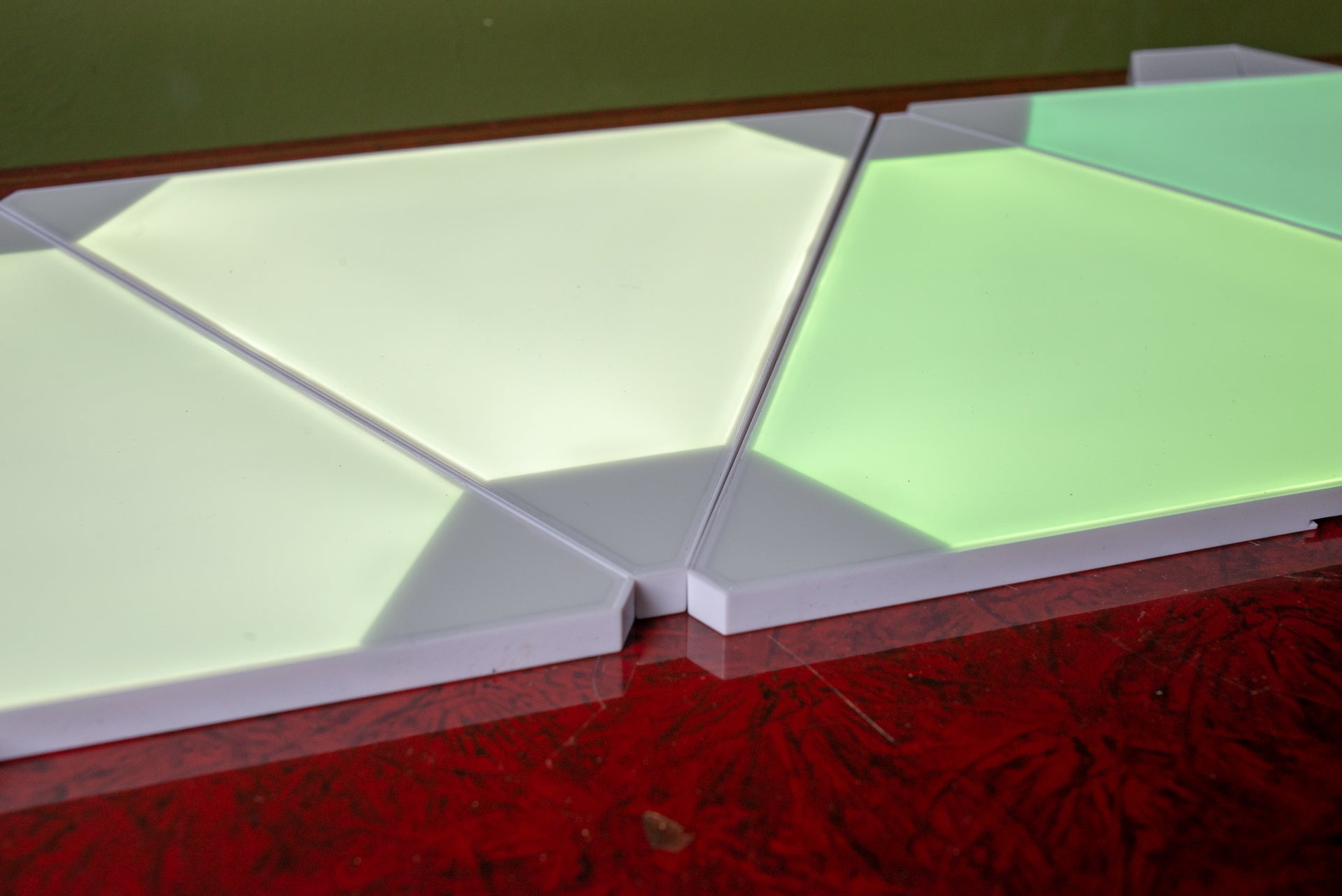
Pros:
- Highly configurable
- Rhythm box dynamically changes light colours
- Excellent colour range
Cons:
- Fiddly to set up
If you fancy something a little bit different, the Nanoleaf Light Panels Aurora Rhythm light panels are the ones for you. Each triangular panel is a full colour-changing light, and you can put up to 30 together to create stunning, arty patterns on your wall (the starter set comes with nine).
However, it’s important to spend time getting the configuration right, as the panels are really fiddly to put together and must be stuck to the wall via the provided sticky fixings.
Mood lighting, rather than replacing existing bulbs, the Aurora can add to a room, giving something of interest to look at. They’re also great fun if you have the Rhythm module connected. This listens out for music and can change panel colour in time to the beat, giving you funky disco lights as well.
App control is excellent, and you can create dynamic, colour-shifting patterns, or just paint the colours that you want. There’s support for Apple Siri, Amazon Alexa and the Google Assistant, too.
A product to complement your existing lighting, the Aurora is a fun way to add colour lighting to your home.
7. Ikea Tradfri
A quality budget lighting system.
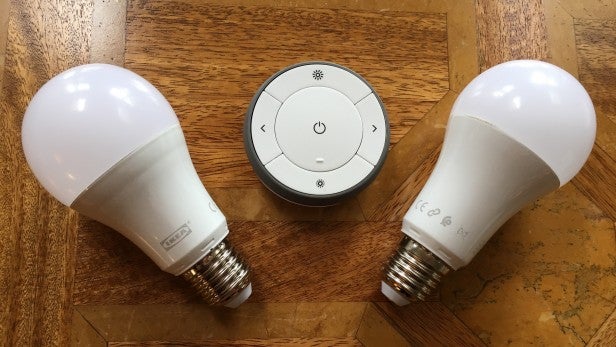
Pros:
- Affordable
- Easy to set up and use
- Well-designed app
- Can be used without Wi-Fi
Cons:
- Few coloured bulbs
- No voice control
- Limited functionality compared to competitors
Who’d have thought that it would be Ikea that would be mounting the biggest challenge to Philips Hue? Yet the Ikea Tradfri is fast becoming one of the best systems, providing everything you want from smart lighting.
The choice of bulbs is excellent taking in E14, E27 and GU 10, with standalone light panels also available; only B22 bulbs are missing from the list. All bulbs are temperature-changing, but there’s so far only a single colour-changing E27 bulb. Even so, the products are well priced a touch cheaper than the Hue options.
Lower cost comes at a price, though, and Ikea gives you fewer control options. While Hue bulbs can change between 16 million colours, Ikea gives you a choice of just 13 colours for its colour bulb.
Ikea uses the Zigbee low-power smart home protocol, which gives the option of dedicated wireless switches, too. In this way, the Tradfri can be controlled just like regular light bulbs. You can buy dedicated switches, dimmers and motion sensors.
Buy the Tradfri gateway and your lights can be connected to your home network, too, giving you full app control, not to mention Amazon Alexa, Apple Siri and Google Assistant control. Third-party support falls behind Hue and there’s no Works with Nest support for example.
Philips Hue gives you the best range of bulbs and control options, but the Ikea Tradfri isn’t too far behind and its system is a fair bit cheaper, too.
That was our pick of the best lighting systems. For more on choosing the right product keep on reading.
Best smart lighting system buying guide
Best smart lighting system – What bulb types do I need?
Look for a smart lighting system that works with your lights. For smart switches that means you need dimmable bulbs for the system to work. If you’re buying smart light bulbs go with the system that supports the light fittings that you have already. This will make installation far easier.
Look out for other options, too. LED strips are a great way of pushing light everywhere, whether it’s under kitchen cupboards or furniture, or even around a skylight.
Best smart lighting system – Do I need colour or temperature changing bulbs?
Standard dimmable bulbs are good for basic control, such as in a hallway, but look to get colour- or temperature-changing bulbs elsewhere. Temperature-changing bulbs let you set the light type, going from bright, intense white for concentrating, to a more relaxed warm white. We find these good for offices and work spaces.
Colour-changing bulbs can completely alter the look and feel of a room. That’s great for entertaining spaces, such as living rooms or kitchens, allowing you to make a real statement.
Best smart lighting system – Which protocol do I need?
Smart lighting systems typically use Wi-Fi or Zigbee to communicate. Using Wi-Fi means that you don’t need a hub, and the lights connect directly to your home network. This is usually quite easy to do, but there are downsides. First, Wi-Fi range and strength impact the lights, and if your wireless network goes down you can’t remote control your lights. Secondly, you can start to overload your network with devices, particularly if you have a lot of bulbs and a cheap wireless router. Finally, if you use Apple HomeKit, each bulb has to be added individually.
Zigbee is a dedicated smart home protocol. It requires a smart home hub connected to your home network. The advantage of Zigbee is that the protocol is more reliable than Wi-Fi and every bulb acts as an extender, increasing range. And, as it’s low-power, you can add battery-powered switches into this system, which will work even if your home network is down. It’s also harder to overload a system: the practical limit if Zigbee is far higher than the number of devices that you will install. Finally, if you use Apple HomeKit, you need only add the hub and all bulbs will be discovered.
Best smart lighting system – What else should I look for?
Look out for automation options, such as the ability to schedule your lights to come on or off automatically. This can make it look as though someone is at home, even when you’re out.
Make sure that the voice assistant you use is supported by your choice of bulb so that you can turn your lights on and off with speech.


